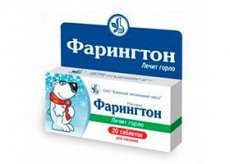Medical expert of the article
New publications
Preparations
Farington
Last reviewed: 03.07.2025

All iLive content is medically reviewed or fact checked to ensure as much factual accuracy as possible.
We have strict sourcing guidelines and only link to reputable media sites, academic research institutions and, whenever possible, medically peer reviewed studies. Note that the numbers in parentheses ([1], [2], etc.) are clickable links to these studies.
If you feel that any of our content is inaccurate, out-of-date, or otherwise questionable, please select it and press Ctrl + Enter.

Farington is a local antiseptic with antioxidant and antimicrobial properties.
Release form
It is produced in the form of tablets that need to be sucked, on blister strips No. 10. One package contains 2 blisters.
 [ 7 ]
[ 7 ]
Pharmacodynamics
The active substance of the drug is chlorhexidine, which has a bactericidal effect on gram-negative and gram-positive microbes (such as Str. mutans, anaerobes, Str. salvarius, Klebsiella, Str. sanquis, Proteus, E. coli, Pseudomonas aeruginosa, Veillonella species, and Selenomonas), and in addition, prevents the growth of candidal fungi, as well as individual mold fungi. This substance blocks the development of protein amino groups that are part of the structure of cytolemmas. It penetrates into the cells of microbes and is embedded in membranes, changing its functioning, settling on the cytoplasm, thereby preventing the penetration of oxygen. This causes a lack of ATP, as a result of which pathogenic microorganisms are destroyed.
Ascorbic acid helps to remove swelling of the mucous membranes, increases the activity of local immunity, and also participates in the process of collagen bonding and tissue restoration.
Pharmacokinetics
Chlorhexidine is not absorbed in the gastrointestinal tract or through mucous membranes. Approximately 10% of the substance is broken down in the liver, and the remainder is excreted unchanged with feces.
Ascorbic acid is well absorbed in the gastrointestinal tract. Plasma protein binding is 25%. During metabolism, it is converted into dihydroascorbic and etadinic acids. It is then excreted from the body with urine.
Dosing and administration
The medicine must be dissolved in the mouth. It must be taken after eating or cleaning the oral cavity - this is necessary so that the drug can remain on the mucous membrane for 2 hours without the risk of being washed away.
You need to take 1 tablet four times a day. The treatment course is 7 days. The treatment can be extended to a maximum of 2 weeks.
Use Farington during pregnancy
There are no studies on the use of chlorhexidine by pregnant women, and no negative effects on the fetus were found in experiments on mice. Therefore, consultation with a doctor is necessary before use.
Side effects Farington
In general, the drug is well tolerated by patients, but sometimes individual allergic reactions may occur, manifested in the form of skin rashes and peeling, nasal congestion, and swelling of the parotid salivary glands.
In some cases, temporary taste bud dysfunction may occur, and stains and plaque may be observed on fillings and tooth enamel. Occasionally, signs of inflammation, dyspepsia and irritation of the oral mucosa may occur. People with intolerance may develop an allergy to Ponceau 4R.
Storage conditions
The medicine must be stored at a temperature no higher than 25 degrees.
Shelf life
Farington is approved for use for 2 years from the date of manufacture of the drug.
Attention!
To simplify the perception of information, this instruction for use of the drug "Farington" translated and presented in a special form on the basis of the official instructions for medical use of the drug. Before use read the annotation that came directly to medicines.
Description provided for informational purposes and is not a guide to self-healing. The need for this drug, the purpose of the treatment regimen, methods and dose of the drug is determined solely by the attending physician. Self-medication is dangerous for your health.

